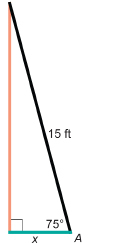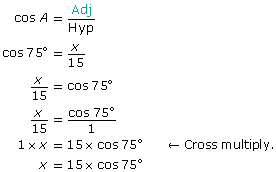Module 7
1. Module 7
1.27. Page 5
Module 7: Trigonometry
Working with the Cosine Ratio
In the next example you will apply your calculator skills to help you solve a problem involving the cosine ratio. There is not much difference between applying the cosine ratio and applying the sine ratio. All you have to remember is that, for the cosine ratio, the adjacent side is used rather than the opposite side.
Example 3

© EML/shutterstock
Angela is painting the exterior of her house. On one side, there is a 5-ft-wide flower garden along the wall. Angela does not want to place the foot of the ladder on her flowers. However, for safety, the ladder must be positioned at a 75° angle with the ground. The ladder is 15 ft in length. Can Angela avoid damaging her flowers if she places the ladder at the correct angle?
Solution
Draw a diagram.
Let x be the distance the foot of the ladder is away from the wall when the ladder leans at 75° to the ground.

Substitute into the formula.

To calculate x, press these keys.
![]()
![]()
The foot of the ladder must be 3.9 m from the wall. Angela will not be able to avoid her flowers. However, with a longer ladder she could avoid the flowers.
 Self-Check
Self-Check
Use the method outlined in Example 3 to solve this question.
SC 8. Solve for x. Round to two decimal places.

Another Angle
You have just seen how an unknown side in a right triangle can be determined using the cosine ratio. You found the cosine ratio from the given measure of an angle. But can you go in the other direction? Can you find the measure of an angle from the cosine ratio?
For instance, suppose you were told that the cosine of an angle in a right triangle is 0.8. What would that angle be?
Example 4
If cos A = 0.8, determine ∠A to the nearest degree.
View the animated “Cosine Solution.”
 Self-Check
Self-Check
Practise finding angles given the cosine ratio.
SC 9. Find ∠A given cos A = 0.6.
To find the angle, use both methods shown in Example 4.
SC 10. Use your calculator to find each angle from its cosine. Round your answers to the nearest tenth.
|
sin A |
∠A |
|
0.1257 |
|
|
0.7826 |
|
|
0.9000 |
|
|
|
|
|
|
|
SC 11. Find ∠A to the nearest tenth of a degree.

 Mastering Concepts
Mastering Concepts
Try this question. When you are finished, check your answer.
MC 1. ΔPQR is a right triangle.

- For ΔPQR, write the ratios for sin P, cos P, sin R, and cos R.
- How are these ratios related?
- How are ∠P and ∠R related?